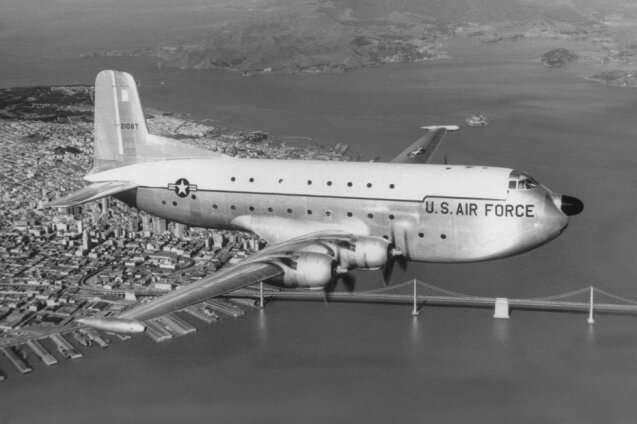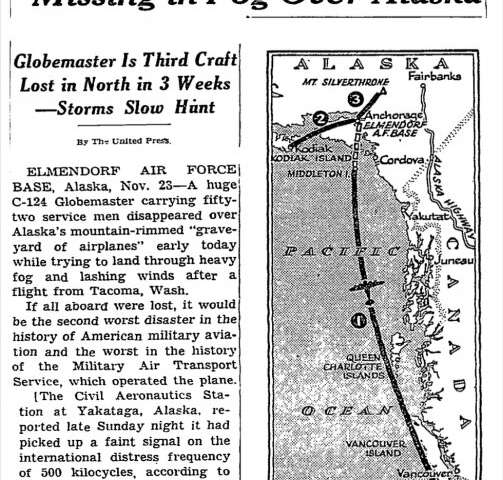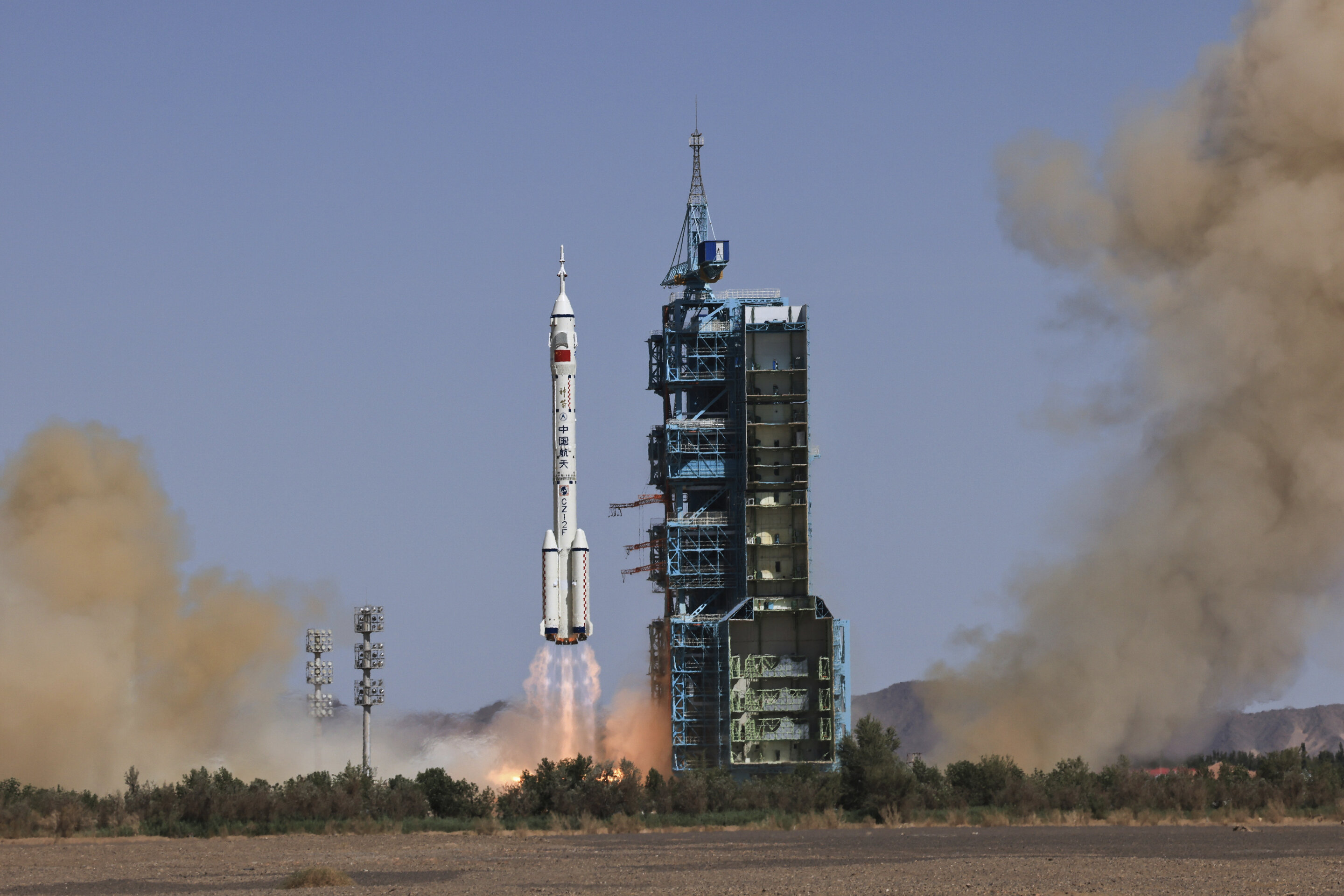#Remains of Cold War plane crash emerging from rapidly melting Alaska glacier
“#Remains of Cold War plane crash emerging from rapidly melting Alaska glacier”

In June this summer, a team of military personnel touched down on Alaska’s Colony Glacier with a somber mission: to recover newly unthawed wreckage and human remains from a fatal Cold War-era plane crash. The plane, en route to Elmendorf Air Force Base in Anchorage, Alaska, went down during a period of rapid militarization in the soon-to-be state. Now, the search for remains draws eerie parallels between Arctic militarism in 1952 and today.
Nicknamed “Old Shaky” for its tendency to vibrate during flight, the enormous Douglas C-124 Globemaster II departed from McChord Air Force Base in Tacoma, Washington early on November 22, 1952. The 52 U.S. military service members aboard the flight never made it to Elmendorf. On the day of the crash, weather near Anchorage was severe, with dense fog and swirling snow obscuring visibility. According to Robert Orlove, a master aviation mechanic and cousin of GlacierHub editor Ben Orlove, landing at a nearby diversion airport was impossible, forcing the pilot to resort to an instrument approach to Anchorage. Under instrument flight conditions, characterized by poor weather, pilots must navigate without outside visual references. However, the flight was equipped only with a radio beacon receiver, barometric altimeter to gauge altitude, and a stopwatch as a means to find the runway. Less than 60 miles from its destination, the plane crashed into the side of Mount Gannett and left no survivors.
Six days passed before the weather permitted a search team to survey the site of the crash. The plane was assessed to have flown into Mount Gannett at full speed, making impact at an elevation of 8,000 feet. In addition to eight feet of fresh snow covering the wreckage, the impact of the crash is thought to have triggered an avalanche that further entombed the debris.

Over time, the wreckage tumbled in slow motion down the mountain, eventually freezing within the nearby Colony Glacier. Efforts to recover remains only began in 2012, when a military training mission in the region noticed a lone yellow life raft atop the ice. Since then, military personnel have conducted annual searches with the ultimate goal of returning remains to surviving family members. All but nine service members aboard the flight have thus far been identified. As climate change accelerates the retreat of Colony Glacier, however, the window for collecting remains and artifacts shrinks. With each year of warming—and melting—the wreckage inches closer to Lake George, into which the glacier feeds. If not recovered in time, the stories held in the scattered remains will fall to the bottom of the lake, from which retrieval is unlikely.
At the time of the crash, the Cold War was still ramping up and the United States’ project of Arctic militarization had yet to reach its zenith. During World War II, however, the United States and the Soviet Union had been allies, even cooperating in the Arctic. David Ramseur, author of Melting the Ice Curtain, explained that these positive wartime relations can be understood by the inclusion of the Soviet Union in the Lend-Lease Act. “We sent almost 8000 airplanes through Alaska to the Soviet Union,” he told GlacierHub, which “was a big part of the alliance between the two countries.” This allied relationship was maintained, in part, on the basis of geographical closeness; the Bering Strait, running between the continents of North America and Asia, is only 53 miles wide at its narrowest point.
This proximity is precisely why Alaska became central to the United States’ military plan during the Cold War. However, the then-territory (Alaska was granted statehood in 1959) emerged as a strategic asset even earlier, with the rise of aviation during the Second World War. Katherine Ringsmuth, professor of history at the University of Alaska Anchorage, explained that as lengthy flights became viable, Alaska’s global positioning catapulted it into the political spotlight. Planes departing from Alaska could now exert greater influence over affairs in the Pacific and Eastern Asia. Ringsmuth told GlacierHub, “these oceans are shrinking because of aviation, and all of a sudden Alaska is on the frontline. It’s not the frontier, it is the frontline of American defense.”

At the time of the crash, international relations were in a period of rapid change and mounting tension. The Korean War, which lasted from 1950 to 1953, had in November of 1952 reached a stalemate of sorts. Essentially a war between communist and capitalist forces, the conflict pitted South Korea and the United States against North Korea (backed by the Soviet Union) and China. In June of 1951, on-the-ground fighting largely ceased, with the conflict transforming into a war of attrition. Hostilities ended when North Korea, China, and the United States reached an armistice on July 27, 1953, but South Korea never agreed to the truce and a formal peace treaty still has yet to be signed. Though often overlooked, the war provides critical context for understanding Arctic militarization. Indeed, the Korean War set the stage for the United States to develop and maintain a global military presence.
Because the Globemaster crashed during such a pivotal period in Alaskan and world history, the event highlights important insights about the militarization of the Arctic at that time. These and other historical moments are preserved in Arctic ice, said Rasmus Bertelsen, professor of northern studies at the Arctic University of Norway. “In a way, these glaciers hold the archaeology of the international politics and international security of the Arctic,” he told GlacierHub. Gradually emerging from the ice are bits and pieces of a story not only about a tragic accident, but about how the United States used the Arctic to secure its position as a superpower.
But though the plane harkens back to a militarized past, its remains are resurfacing in a renewed period of Arctic militarization. Essentially, Bertelsen explained, the United States continues to be far more involved in the Arctic than is generally understood. After the dissolution of the Soviet Union, the United States’ globalized military influence remained intact. Accordingly, of the eight Arctic States which comprise the Arctic Council, the United States maintains the greatest global power, and behaves in line with its status. “The United States spends a lot of resources in the Arctic,” Bertelsen said. “This enormous Cold War—and nuclear and early warning and now missile defense infrastructure—that is of course the infrastructure, and it’s the thinking, of a superpower. That’s not what Canada does, that’s not what the Nordic countries do… The United States is very much engaged in the Arctic for superpower reasons.”
Now, as glaciers retreat and sea ice melts, the physical and geopolitical landscape of the Arctic is shifting dramatically, setting the stage for even more superpower flexing. China, for example, has been asserting its rights to participate in the Arctic as a legitimate stakeholder, and in 2013 the country was granted observer status by the Arctic Council. Russia is gaining support on a claim to jurisdiction over 463,000 square miles of Arctic sea shelf, which extends over 350 nautical miles from the nation’s shore. Meanwhile, in August of 2019, advocates for the purchase of Greenland by the United States saw the move as an appropriate response to China and Russia’s heightened Arctic engagement. Denmark’s rejection of the proposal provoked tense relations between the two nations.
Extraction of natural resources, national security, and the opening of new global transport routes are among the key issues at stake today. Many countries still in pursuit of fossil fuels have their eyes on the Arctic, which possibly holds the world’s last untapped oil and gas reserves. The U.S. Navy is, for the first time since the Cold War ended, traveling regularly to the Arctic Circle. As melting ice caps create new northern trade routes, different nations’ ability to compete for access depends largely on how many icebreakers they possess. And Arctic military flights are ramping up too, with a sense of suspicion permeating the airspace.
As the annual search team races to pick up all that remains from the Globemaster and the service members inside, the bagged artifacts and human remains serve as an unsettling forewarning for a highly militarized future.
This story is republished courtesy of Earth Institute, Columbia University http://blogs.ei.columbia.edu.
Remains of Cold War plane crash emerging from rapidly melting Alaska glacier (2020, July 28)
retrieved 28 July 2020
from https://phys.org/news/2020-07-cold-war-plane-emerging-rapidly.html
This document is subject to copyright. Apart from any fair dealing for the purpose of private study or research, no
part may be reproduced without the written permission. The content is provided for information purposes only.
If you want to read more Like this articles, you can visit our Science category.
if you want to watch Movies or Tv Shows go to Dizi.BuradaBiliyorum.Com for forums sites go to Forum.BuradaBiliyorum.Com

